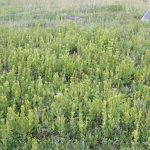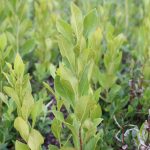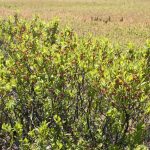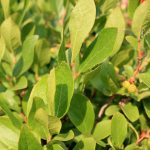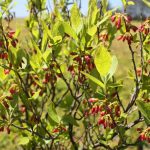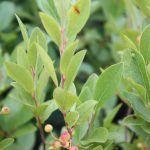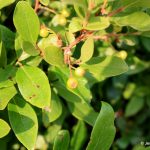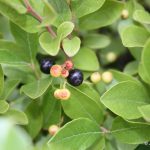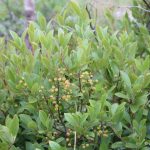Black huckleberry
Prepared by Jennifer L. D’Appollonio, Assistant Scientist, University of Maine, Orono, ME 04469. Updated February 2018.
Scientific name: Gaylussacia baccata (Wangenh.) K. Koch
Common name(s): black huckleberry
Links: USDA PLANTS Profile, NPIN Profile, Go Botany
Images: (to see enlargements [PC]: click on image, then right click and choose “view image”)
- pruned, in blueberry field
- close-up, pruned plant
- not pruned
- golden resin glands on lower leaf surface
- flowering, early June
- mid-July – leaves are yellow-green
- immature berries, mid-July. Mature berries are blue-black w/10 seeds
- immature and mature berries
- late July
Description:
– generally flowers in June in ME
– ripe edible fruit in August
-Twigs are gray to brown with scattered lenticels
- covered with dense white hairs
- Older stems smooth and covered with whitish film
-Buds slender and sharp-pointed
- terminal bud are prominent with lateral buds pressed against the twig
- Bud scales are shiny with two notches at the tip
-Alternate leaves
- ovate-lanceolate
- fine-toothed
- dark green and shiny above paler below usually tapering to the base and abruptly pointed
- Midvein with tiny dark glands along the upper side
-Flowers five parted, ten stamens
- 3-4mm long
- yellow to red
-Fruit:
- black drupe
- ripens in late summer
– may be confused with G. bigeloviana, or G. frondosa outside of ME; see left sidebar on Go Botany webpage
Habitat:
-acidic soils
-plains
-wet bogs
Natural History:
-Native Americans dried them for winter use
Source(s):
Grob, Barbara Lukacs. “Kasey Hartz Natural Area Reference SheetGaylussacia Baccata (Wangenh.) K.KochHuckleberry.” Kasey Hartz Natural Area Reference Sheet, Muskegon Community College , Dec. 2007, www.muskegoncc.edu/Include/Life%20Science/Kasey%20Hartz%20Nature%20Trail/Reference%20Sheets%20KHNA/Gaylussacia.pdf.
Hansen, R.W., S.B. Hansen and E.A. Osgood. 1991. Reproductive phenologies of selected flowering plants in eastern Maine forests. ME Agric. Exp. Station Tech. Bull. 143. 17 pp.
Heinrich, B. 1976. Flowering phenologies: Bog, woodland, and disturbed habitats. Ecology. 57(5):890-899.

